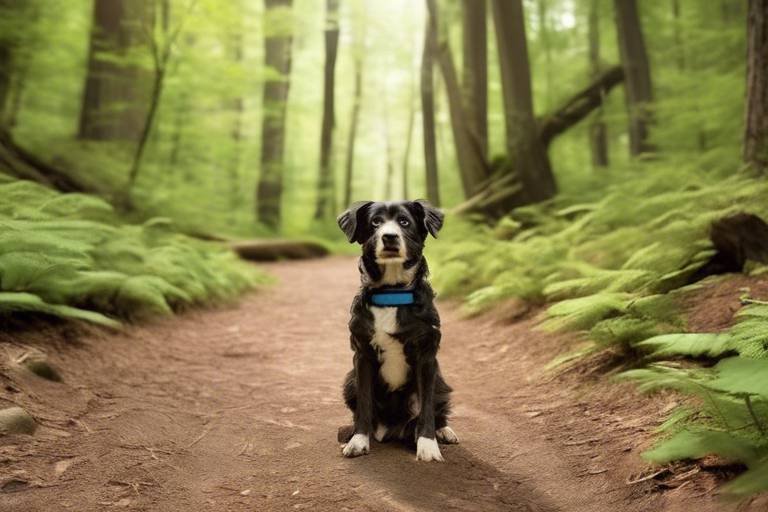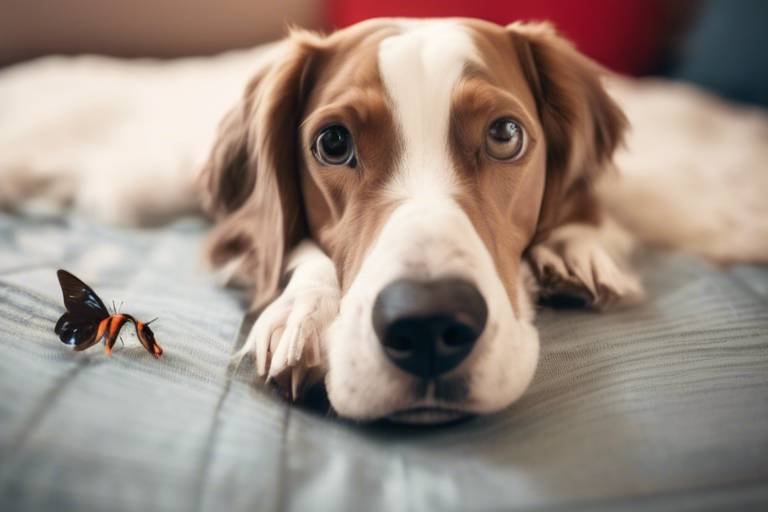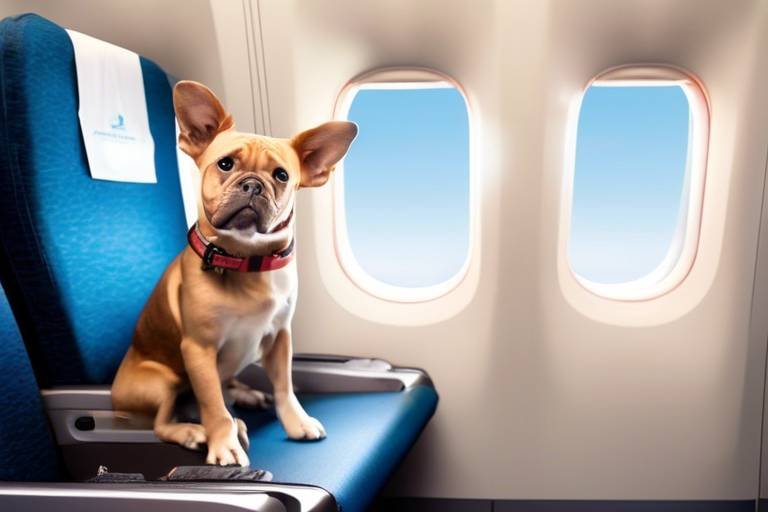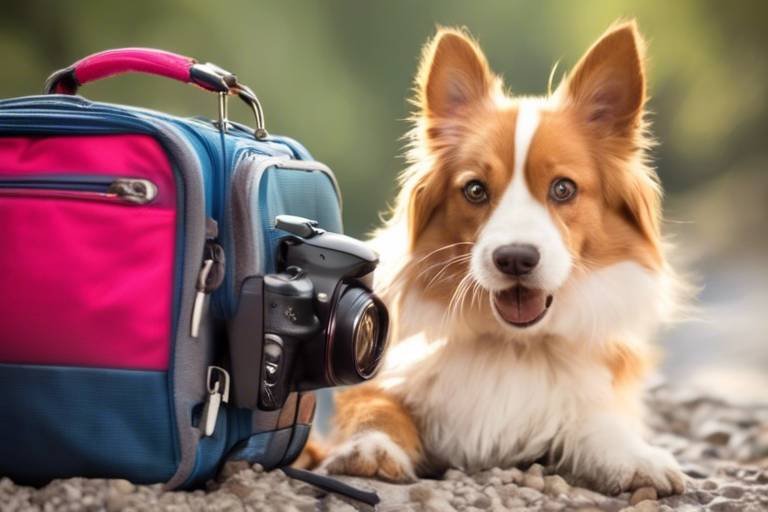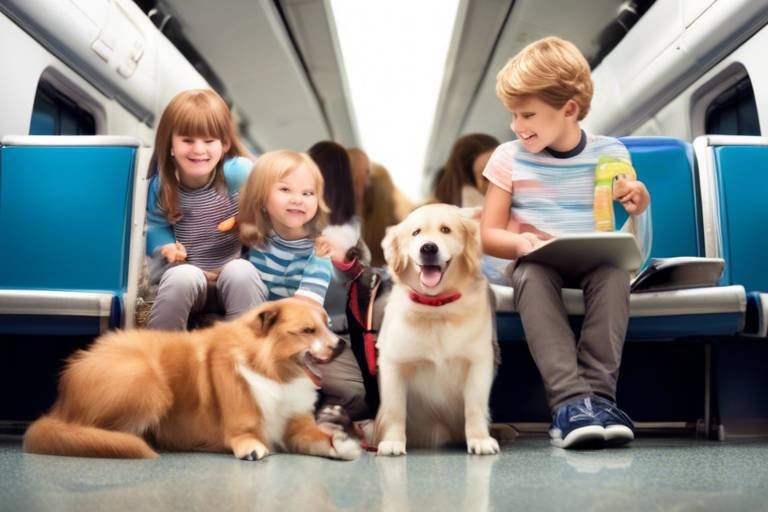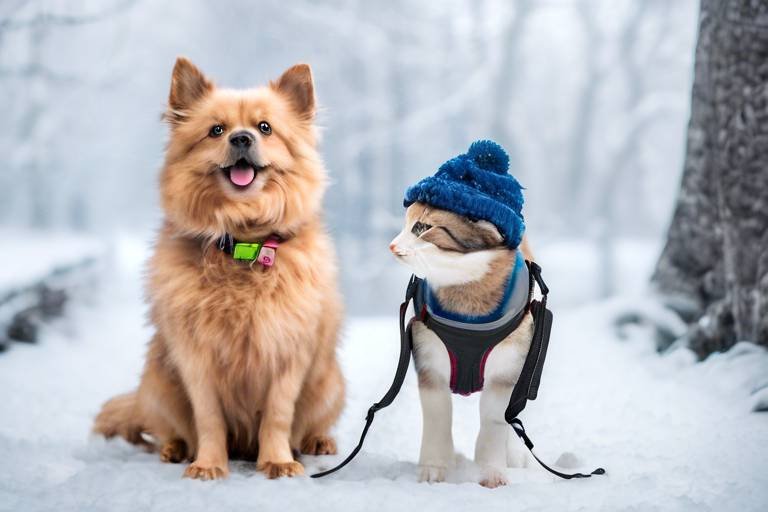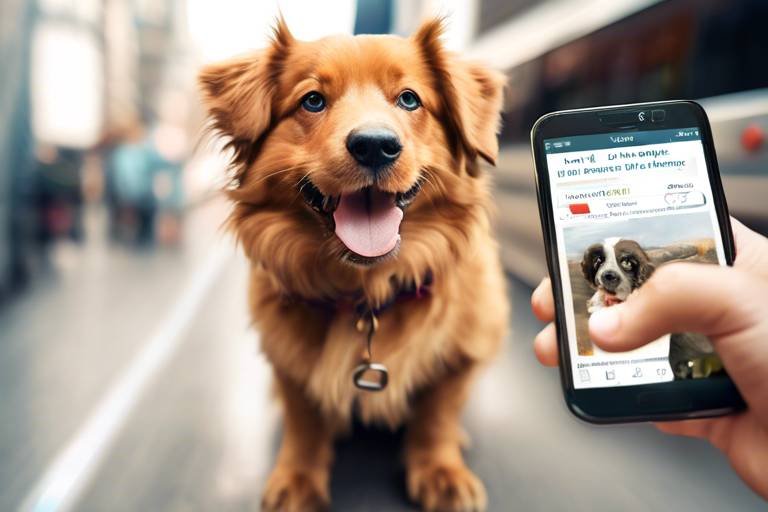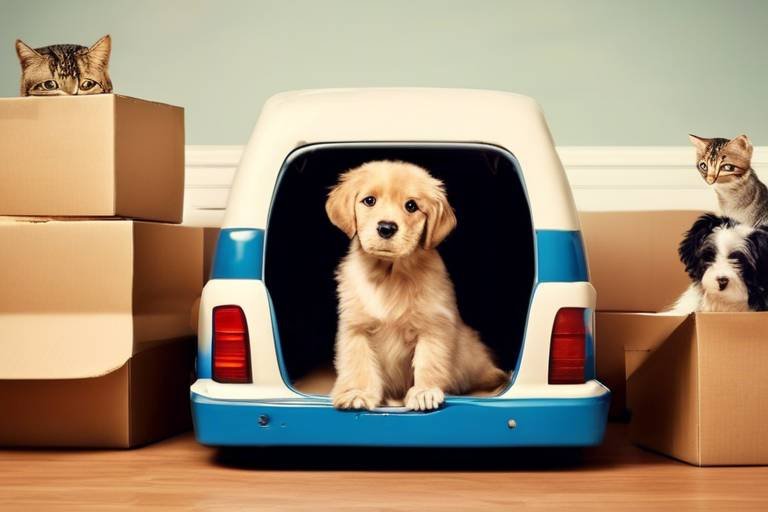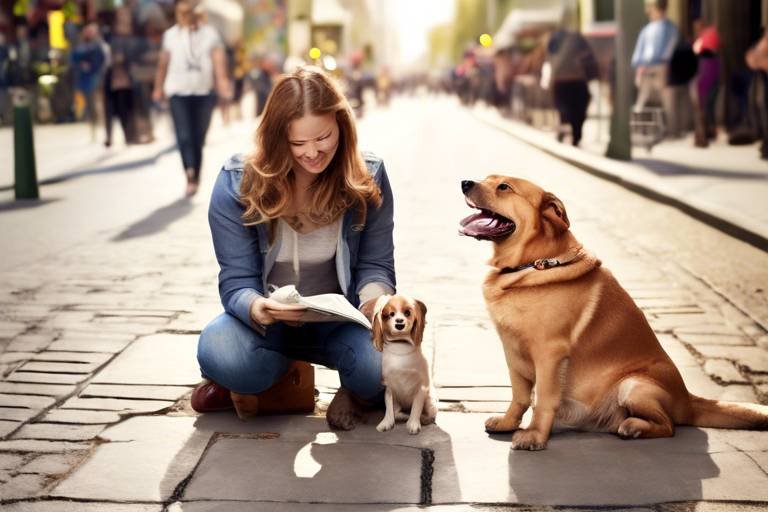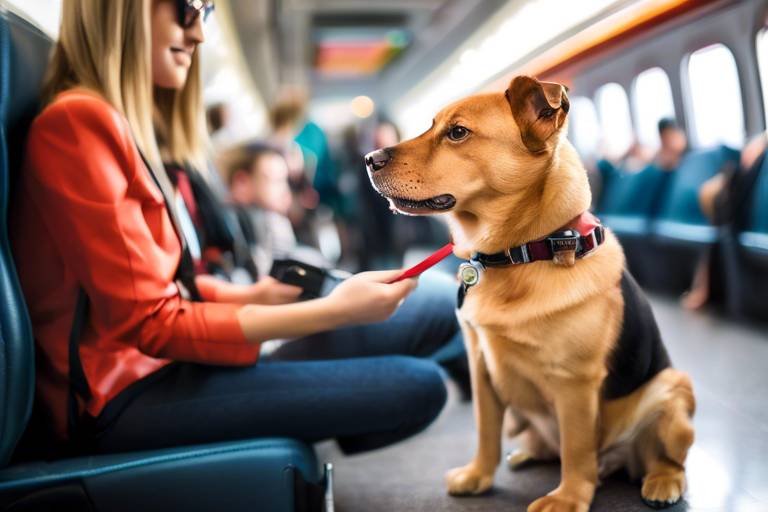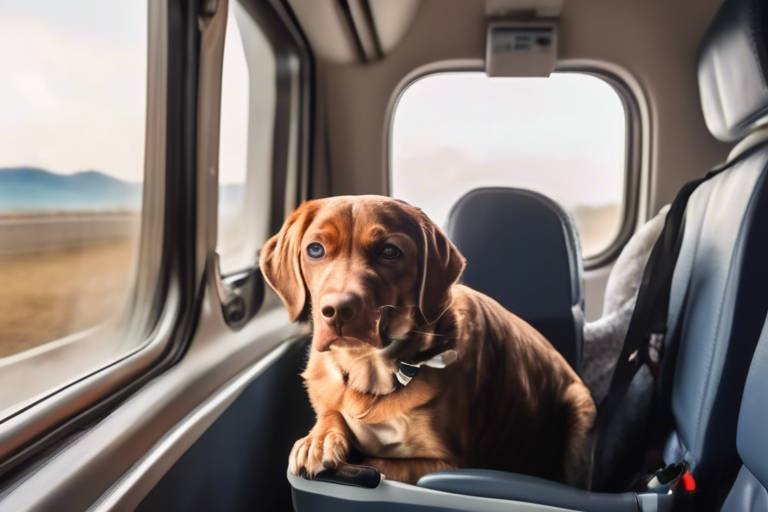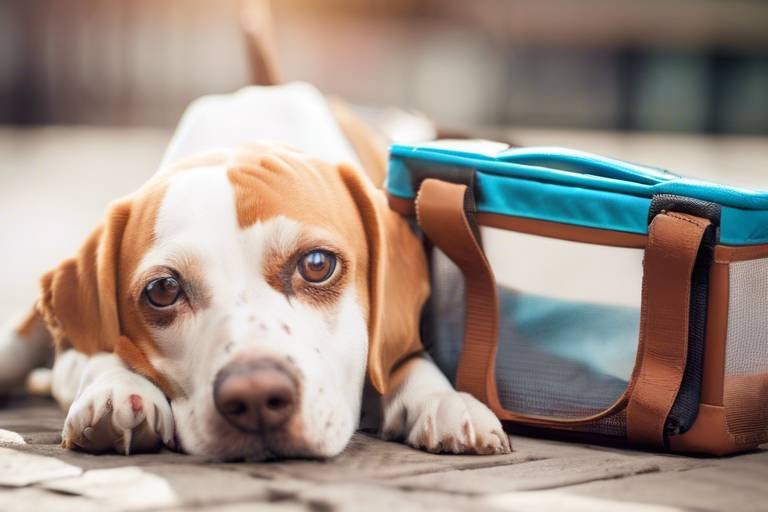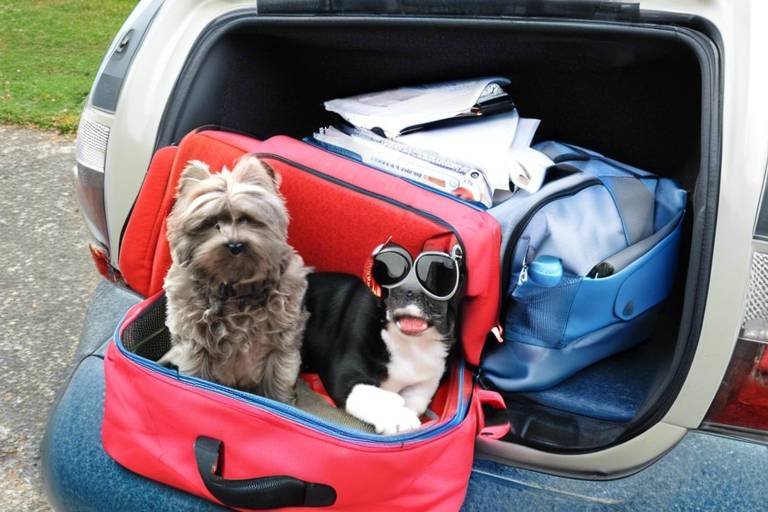The Best Practices for Packing Your Pet’s Essentials
Traveling with your furry friend can be one of the most rewarding experiences, but it also comes with its own set of challenges. To ensure that both you and your pet have a smooth journey, it’s essential to pack wisely. Think of packing for your pet as preparing for a mini adventure. Just like you wouldn’t head out without your favorite snacks or a cozy blanket, your pet deserves the same level of care and attention. This article explores essential tips for packing your pet's belongings for travel, ensuring their comfort and safety. Discover practical advice to make your journey enjoyable for both you and your furry friend.
Every pet has unique requirements that should be taken into account before hitting the road. Just as humans have different preferences and needs, so do our pets. Understanding these needs is crucial when packing. For instance, consider factors like your pet's size, breed, and temperament. A small dog may require different supplies than a large breed, and a high-energy cat may need more toys to keep entertained. By catering to these specific needs, you can ensure a smoother travel experience. Ask yourself: What makes my pet feel safe and happy? This simple question can guide your packing decisions and help you include all necessary items for a stress-free trip.
Creating a checklist can streamline the packing process and help keep you organized. Imagine the chaos of realizing you’ve forgotten your pet’s favorite toy or essential medications halfway through your journey! To avoid such mishaps, here’s a quick rundown of must-have items:
- Food and Water Supplies: Enough food and water are vital for your pet’s health during travel.
- Comfort Items: Bring along familiar toys and blankets to ease anxiety.
- Medical Supplies: Don’t forget any medications or a first aid kit.
- Identification: Ensure your pet has proper ID tags and consider microchipping.
With this checklist in hand, you’ll be well-prepared to hit the road without any last-minute scrambling.
Packing enough food and water is not just a good idea; it’s vital for your pet’s health during travel. Just like you wouldn’t want to go on a long trip without snacks, your pet deserves to stay nourished and hydrated too. Measure out portions ahead of time and pack them in suitable containers. Look for travel-friendly options that make feeding easy, such as resealable bags or portable food containers.
Selecting the right food for your pet is crucial. Think about their dietary needs and any food sensitivities they may have. Travel-friendly options like dry food or pre-packaged meals can simplify feeding during your trip. It’s like choosing the perfect road trip snacks—convenience is key!
Keeping your pet hydrated is just as important as providing food. Explore portable water bowls and hydration packs that make it easy to provide fresh water anytime, anywhere. Imagine being on a hot day and not having a way to quench your thirst; your pet feels the same way! Having a reliable water source can make all the difference.
Including comfort items can help ease your pet’s anxiety during travel. Familiar toys, blankets, or even a favorite pillow can create a sense of security for your furry companion. Think of these items as their little piece of home on the road. When your pet feels comfortable, the journey becomes much more enjoyable for both of you.
Prioritizing safety is crucial when traveling with pets. Just as you buckle up for safety in a vehicle, your pet needs to be secured too. This section discusses how to properly secure your pet in the vehicle and the importance of identification tags and microchipping for emergencies. It’s all about ensuring peace of mind while you’re on the go.
Learn how to safely transport your pet in a vehicle. Using crates, seatbelts, or harnesses can prevent distractions and ensure safety during the journey. Think of it this way: just as you wouldn’t let a toddler roam free in a moving car, your pet deserves the same level of protection. Secure them properly to avoid any accidents.
Being prepared for emergencies is vital. Carry essential items like a first aid kit and contact information for local veterinarians. Imagine being on a road trip and facing an unexpected situation—having the right resources can make all the difference. Being proactive means you can handle any situation with confidence.
Q: What should I do if my pet gets anxious during travel?
A: Bring along comfort items like toys or blankets that smell like home. Regular breaks can also help them stretch and relieve anxiety.
Q: How can I keep my pet hydrated on long trips?
A: Use portable water bowls and offer water regularly. Consider bringing a hydration pack for easy access.
Q: Is it necessary to have my pet microchipped?
A: Yes, microchipping provides a permanent form of identification in case your pet gets lost during travel.

Understanding Your Pet's Needs
Every pet is unique, much like their human companions. Understanding your pet's specific needs is crucial when packing for travel. Imagine embarking on a journey without your favorite snacks or comfort items; your pet feels the same way! Factors such as size, breed, and temperament play significant roles in determining what to pack. For instance, a small, anxious Chihuahua might require different comfort items compared to a laid-back Golden Retriever. It’s essential to tailor your packing list to cater to these individual needs.
Additionally, consider your pet's age and health status. An older pet might need specialized food or medications, while a younger, more active pet could require extra toys to keep them entertained during long trips. Think about their daily routines as well. If your furry friend is used to a specific schedule for meals and potty breaks, try to maintain that routine as closely as possible, even while on the road. This consistency can help reduce anxiety and keep them calm.
To make things easier, you might want to create a personalized checklist based on your pet's requirements. Here are some essential categories to consider:
- Food and Water: Ensure you have enough food for the duration of your trip, along with portable water solutions.
- Comfort Items: Bring along their favorite blanket or toy to provide a sense of security.
- Health Needs: Include any medications or medical supplies that your pet may require.
- Identification: Ensure your pet has proper identification, such as tags and microchips, in case you get separated.
Moreover, understanding your pet's behavior is equally important. Some pets may thrive on adventure and new experiences, while others may feel overwhelmed by unfamiliar environments. Pay attention to their body language and reactions. If they seem stressed or anxious, it might be time to take a break or provide some comfort. Ultimately, the goal is to create a travel experience that is enjoyable and stress-free for both you and your furry friend.
In conclusion, taking the time to understand your pet's needs can make all the difference in ensuring a smooth travel experience. By considering their unique characteristics and preferences, you can pack thoughtfully and create an environment that keeps them comfortable and happy throughout your journey.

Essential Packing Checklist
Packing for your pet might seem like a daunting task, but with the right approach, it can be as easy as pie! To ensure you don’t forget anything crucial, creating an can be a game-changer. This checklist will help you gather everything your furry friend needs for a smooth journey. Remember, the key is to think about your pet’s comfort and safety, so you can both enjoy the adventure ahead!
First things first, let’s break down the necessary items. You’ll want to include food, water, comfort items, and safety gear. Each category plays a significant role in making your pet feel at home, even when you’re miles away. Here’s a quick overview of what to consider:
| Category | Items to Pack |
|---|---|
| Food and Water |
|
| Comfort Items |
|
| Medical Supplies |
|
| Identification |
|
When it comes to food and water supplies, make sure to pack enough to last for the entire journey, plus a little extra just in case. It’s best to stick with your pet’s usual food to avoid any tummy troubles. If you’re traveling by car, consider bringing a cooler to keep their food fresh. For water, portable bowls are a must-have; they’re lightweight, easy to pack, and can be used anywhere.
Comfort items are equally important. Think of your pet’s favorite toys or a blanket that smells like home. These familiar objects can help soothe their nerves during travel. Just like how we might carry a beloved book or a cozy sweater, pets also appreciate having something that reminds them of their safe space.
Lastly, don’t forget about safety and identification. Having a first aid kit on hand is essential for any unexpected mishaps. Include items like antiseptic wipes, bandages, and any medications your pet might need. Also, ensure your pet has a collar with an ID tag that contains your contact information. Microchipping is another excellent way to ensure your pet can be identified if they get lost.
By following this essential packing checklist, you’ll be well-prepared for your journey. Remember, a little planning goes a long way in ensuring that both you and your furry companion have a fantastic travel experience!
Q: How do I determine how much food to pack for my pet?
A: A good rule of thumb is to pack enough food for the duration of your trip, plus an extra day’s worth. Measure out portions using your pet's usual feeding guidelines, and consider bringing a bit extra in case of delays.
Q: What should I do if my pet gets anxious during travel?
A: Bringing along comfort items like their favorite blanket or toy can help. Additionally, consider talking to your vet about calming supplements or strategies to help ease their anxiety.
Q: Is a microchip necessary if my pet has an ID tag?
A: While ID tags are important, microchipping provides a permanent form of identification that can be scanned by shelters or vets if your pet gets lost. It’s a good idea to have both!
Food and Water Supplies
Packing the right food and water supplies for your pet is not just a matter of convenience; it’s a crucial aspect of ensuring their health and well-being during travel. Imagine embarking on a long road trip with your furry friend, only to realize halfway through that you’ve forgotten their food! Panic sets in, and the last thing you want is to compromise your pet's diet or hydration. To avoid such scenarios, it’s essential to plan ahead and pack adequately.
First and foremost, consider how much food your pet typically consumes in a day. It's wise to measure out their portions in advance, so you know exactly how much to bring. For instance, if your dog eats 2 cups of food per meal and you’re traveling for two days, you’ll need at least 12 cups of food, plus a little extra just in case. This can be easily done using resealable bags or airtight containers that keep the food fresh and safe from pests.
When it comes to choosing the right containers, opt for lightweight, spill-proof options. There are various travel bowls available that collapse for easy storage and expand when it's time to feed or hydrate your pet. Look for bowls made from durable materials that can withstand the rigors of travel. Additionally, consider packing a portable water bottle designed for pets. These bottles usually come with an attached bowl or a flip-top that allows you to dispense water easily.
Speaking of hydration, keeping your pet hydrated is absolutely essential, especially on warm days or during long journeys. Dehydration can lead to serious health issues, so it's important to have a plan. Portable water solutions can make this task easier. For instance, there are hydration packs that are designed specifically for pets, allowing you to carry fresh water without the bulk of traditional water containers. This way, you can easily refill your pet's bowl whenever they need a drink.
In addition to food and water, think about your pet's dietary restrictions or preferences. If your furry friend has a sensitive stomach or specific dietary needs, it’s wise to bring their usual food to avoid any digestive issues. You might also consider packing some treats to reward your pet during the journey. Treats can be a great motivator, especially during long stretches of travel.
To summarize, here’s a quick checklist for packing food and water supplies for your pet:
- Measured portions of your pet's regular food
- Airtight containers or resealable bags
- Portable, spill-proof food and water bowls
- A hydration pack or portable water bottle
- Your pet's favorite treats
By preparing in advance and packing the right supplies, you can ensure that your pet stays happy and healthy throughout your travels. Remember, a well-fed and hydrated pet is a content pet, ready to enjoy the journey just as much as you are!
Choosing the Right Food
When it comes to traveling with your pet, selecting the right food is not just about convenience; it's about ensuring your furry friend stays healthy and happy throughout the journey. Just like us, pets have their own dietary needs based on factors such as age, size, breed, and health conditions. Before you hit the road, take a moment to evaluate what your pet requires. This can be a game changer in keeping their energy levels up and preventing any tummy troubles during your travels.
One of the best strategies is to stick with the food your pet is already accustomed to. This minimizes the risk of digestive issues that can arise from sudden dietary changes. If your pet is used to a specific brand or type of food, make sure to pack enough to last the entire trip, plus a little extra in case of delays. It’s always better to be over-prepared than to run out!
When choosing food for travel, consider options that are easy to pack and serve. For instance, dry kibble is often preferable over wet food since it doesn’t require refrigeration and is less messy. Additionally, look for travel-friendly packaging, such as resealable bags or single-serving pouches, which can help with portion control and make feeding on the go a breeze.
Here’s a quick breakdown of food types to consider:
- Dry Food (Kibble): Lightweight, easy to store, and mess-free. Perfect for long trips.
- Wet Food: More palatable for some pets but requires refrigeration. Consider bringing it for shorter trips.
- Pre-packaged Meals: Convenient and portioned, these can be a lifesaver if you’re short on time.
Don’t forget about treats! They can be a great way to reward your pet for good behavior during the journey or to simply keep them occupied. Just make sure that any treats you bring are also travel-friendly and won’t spoil easily.
Lastly, always have a plan for feeding times. Try to maintain your pet’s regular feeding schedule as much as possible. This consistency can help reduce anxiety and make the travel experience smoother for both you and your pet. By carefully choosing the right food and planning ahead, you can ensure that your pet remains comfortable and content on your adventures together.
Q: How much food should I pack for my pet?
A: A good rule of thumb is to pack enough food for the duration of your trip, plus an extra day’s worth, just in case of delays.
Q: Can I change my pet's food during travel?
A: It's best to stick to their regular food to avoid digestive issues. If you must change it, do so gradually.
Q: What if my pet has special dietary needs?
A: Always consult with your veterinarian beforehand and pack the necessary food that meets your pet's specific dietary requirements.
Hydration Solutions
Keeping your pet hydrated during travel is not just a good idea; it's a necessity! Just like humans, our furry friends can become dehydrated, especially on long journeys or during hot weather. So, how do you ensure your pet has access to fresh water wherever you go? The answer lies in the right hydration solutions.
One of the most practical options is a portable water bowl. These bowls come in various designs, from collapsible silicone bowls to lightweight plastic ones. They’re easy to pack and can be set up in seconds. Imagine pulling over at a rest stop and being able to whip out a bowl for your thirsty pup! It’s that simple. Just make sure to choose one that’s spill-proof to avoid any mess in your car.
In addition to portable bowls, consider investing in a hydration pack. These packs are designed for active pets and can be filled with water, allowing you to provide hydration on the go without needing to stop. They often come with a built-in bowl or a nozzle for easy access, making it a breeze to keep your pet hydrated during hikes or long walks.
When packing water for your trip, it's also a good idea to think about the quantity. Generally, you should aim for about one ounce of water per pound of your pet's weight each day. However, this can vary based on the temperature and activity level. To help you visualize this, here’s a quick reference table:
| Pet Weight (lbs) | Daily Water Requirement (oz) |
|---|---|
| 10 | 10 |
| 20 | 20 |
| 30 | 30 |
| 50 | 50 |
| 70 | 70 |
Finally, always make sure to carry extra water, especially if you’re heading to remote areas where clean water might not be readily available. Keeping your pet hydrated should be a top priority, so don't hesitate to stop and offer them a drink whenever you can. A well-hydrated pet is a happy pet, and a happy pet makes for a more enjoyable travel experience for everyone involved!
Comfort Items
Traveling with your furry friend can be a delightful adventure, but it can also be a bit stressful for them. Just like us, pets can feel anxious when they're in unfamiliar environments or when their routines are disrupted. To help ease their anxiety and make the journey more enjoyable, it's essential to pack some that can provide a sense of security and familiarity. Think of these items as your pet's little slice of home, which can make all the difference in their travel experience.
First and foremost, consider bringing along your pet's favorite blanket or bed. This is not just any blanket; it should be something they associate with comfort and safety. The familiar scent of their own bedding can have a calming effect, helping them feel more at ease during the journey. If you're traveling by car, placing their bed in a secure spot can also make them feel more secure.
In addition to a cozy blanket, don't forget to pack a few of their favorite toys. Toys can serve as a great distraction and can help alleviate boredom during long trips. Whether it’s a squeaky toy, a soft plush, or even a simple ball, having something to chew on or play with can keep your pet entertained and reduce anxiety. Try to choose toys that are durable and easy to clean, especially if you're anticipating a messy adventure.
Another great comfort item is a travel crate or carrier. This can be a safe haven for your pet while on the road. Make sure it’s well-ventilated and spacious enough for them to stand, turn around, and lie down comfortably. You can also place a familiar blanket or a piece of your clothing inside, as these scents can provide reassurance. If your pet is crate-trained, they might feel more secure in their carrier, which can help them relax during the journey.
Lastly, consider bringing along some calming aids. These can range from natural remedies like pheromone sprays to calming music specifically designed for pets. Many pet owners swear by these products, claiming they help create a peaceful atmosphere during travel. You might also want to consult your veterinarian for recommendations on calming supplements that are safe for your pet.
In conclusion, packing the right comfort items can significantly enhance your pet's travel experience. By providing familiar scents, toys, and safe spaces, you're not just making the journey more enjoyable for them; you're also reducing the likelihood of stress-related issues. Remember, a happy pet means a happy trip for everyone involved!
- What are the best toys to bring for my pet during travel?
Choose durable toys that your pet enjoys, such as chew toys or plush toys. It's best to bring toys that are easy to clean and won't create a mess in the car.
- How can I calm my pet during long trips?
Consider using calming aids like pheromone sprays or calming music. Familiar items like blankets and toys can also help soothe your pet.
- Is it necessary to use a travel crate?
While it's not mandatory, a travel crate can provide a safe and secure space for your pet, especially during car rides. It can help prevent distractions and keep your pet safe in case of sudden stops.

Safety Precautions
When it comes to traveling with your furry friend, prioritizing safety is not just a good idea—it's essential! Just like you wouldn’t embark on a road trip without your seatbelt, your pet deserves the same level of protection. Imagine the peace of mind you'll have knowing your four-legged companion is secure and comfortable in the vehicle. So, how can you ensure your pet's safety while on the road? Let's dive into some key considerations!
First and foremost, securing your pet in the vehicle is crucial. This can be achieved through various methods, depending on your pet's size and temperament. For larger dogs, using a sturdy crate is often the best option. A well-ventilated crate not only keeps your pet safe but also gives them a sense of familiarity. For smaller pets, consider using a pet seatbelt or a harness that attaches to the car’s seatbelt. This way, you can prevent distractions while driving and ensure your pet stays put, just like a well-behaved passenger!
Another important aspect of pet safety is identification. Imagine the worst-case scenario: your pet gets loose in an unfamiliar area. Having proper identification can be a lifesaver. Make sure your pet wears an ID tag with your contact information. Additionally, consider microchipping your pet for an extra layer of security. Microchips are small devices implanted under your pet's skin that contain your contact info, making it easier for shelters and vets to reunite you with your beloved companion should they wander off.
Now, let’s talk about emergency preparedness. No one likes to think about emergencies when traveling, but being prepared can make all the difference. It’s wise to carry a pet first aid kit that includes essentials such as bandages, antiseptic wipes, and any medications your pet may need. Furthermore, having the contact information for local veterinarians or animal hospitals along your route can save precious time in case of an emergency. You can create a simple table to keep this information organized:
| Location | Veterinarian Name | Contact Number |
|---|---|---|
| City A | Vet Clinic A | (123) 456-7890 |
| City B | Vet Clinic B | (234) 567-8901 |
| City C | Vet Clinic C | (345) 678-9012 |
In conclusion, keeping your pet safe while traveling is all about preparation and awareness. By taking the time to secure your pet, provide proper identification, and prepare for emergencies, you can ensure a smooth and enjoyable journey for both of you. Remember, a little planning goes a long way in creating a safe environment for your furry friend!
Curious about traveling with your pet? Here are some frequently asked questions that might help you out:
- What is the best way to secure my pet in the car? Using a crate or a pet seatbelt is highly recommended for safety.
- Should I get my pet microchipped before traveling? Yes! Microchipping provides an extra layer of safety in case your pet gets lost.
- What should I include in my pet's first aid kit? Essential items include bandages, antiseptic wipes, and any necessary medications.
Vehicle Safety Tips
When it comes to traveling with your furry friend, ensuring their safety in the vehicle is paramount. Just like you wouldn’t drive without a seatbelt, your pet deserves the same level of protection. Imagine your pet as a child in the backseat; you wouldn’t let them roam freely, right? The first step in vehicle safety is to choose the right method of restraint. Crates, seatbelts, and harnesses are all excellent options, but which one is best for your pet?
For smaller pets, a well-ventilated crate can be a cozy and secure space. Make sure the crate is secured in the vehicle to prevent it from sliding around during sudden stops or turns. If you have a larger dog, consider using a pet seatbelt or a harness specifically designed for car travel. This not only keeps them safe but also minimizes distractions while you’re driving. After all, a distracted driver is a dangerous driver!
Another important aspect of vehicle safety is to avoid letting your pet stick their head out of the window. While it may seem like a fun ride, it poses serious risks, such as debris hitting their eyes or them jumping out unexpectedly. Instead, crack the window just enough for fresh air without compromising their safety. If your pet enjoys looking out, consider getting a pet car seat that allows them to see the world safely.
Don’t forget about the temperature inside the car. Pets can overheat quickly, especially during the hot summer months. Always ensure your vehicle is well-ventilated and never leave your pet unattended in the car, even for a short period. A hot car can become a death trap in just minutes. If you’re planning a long trip, make frequent stops to let your pet stretch their legs and relieve themselves.
Lastly, familiarize yourself with your pet’s behavior in the car. Some pets may experience anxiety or motion sickness. If your pet is prone to anxiety, consider bringing along their favorite blanket or toy to provide comfort. For those prone to motion sickness, consult your veterinarian about possible remedies before hitting the road. Remember, a calm pet makes for a much more enjoyable journey for everyone involved!
- What is the safest way to transport my pet in a car?
Using a crate, pet seatbelt, or harness is the safest method. Ensure whatever you choose is properly secured to prevent movement during travel. - Can I leave my pet in the car while I run errands?
No, it’s best to never leave your pet unattended in a vehicle, especially in warm weather, as it can lead to overheating. - How can I help my pet with travel anxiety?
Bring familiar items like their favorite blanket or toy, and consider using calming products recommended by your veterinarian.
Emergency Preparedness
When embarking on a journey with your beloved pet, being prepared for emergencies is not just a good idea—it's essential! Think of it as packing a safety net for your furry friend. You never know when a situation might arise, so having the right supplies can make all the difference. Start by assembling a pet-specific emergency kit that includes crucial items such as a first aid kit, extra food, and water, as well as any medications your pet may need. This kit should be easily accessible, so you can grab it at a moment's notice.
Consider keeping a list of local veterinarians handy, especially if you're traveling to unfamiliar areas. Having this information readily available can save precious time in case of an emergency. You can create a simple table to organize this vital information:
| Veterinarian Name | Address | Phone Number |
|---|---|---|
| Dr. Smith's Animal Clinic | 123 Pet Lane, Furry Town | (123) 456-7890 |
| Paws & Claws Veterinary Hospital | 456 Bark Ave, Woof City | (987) 654-3210 |
In addition to these essentials, make sure to include your pet's medical records in your emergency kit. This documentation should detail any health issues, allergies, or vaccinations your pet has received. It's like having a medical history on hand that could be a lifesaver in critical situations.
Moreover, don’t forget about identification! Ensure your pet has a collar with an ID tag that includes your contact information. Microchipping is another effective way to ensure your pet can be identified if they get lost. This tiny chip, implanted under your pet's skin, can be scanned by veterinarians or shelters, providing a reliable way to reunite you with your furry companion.
Lastly, practice makes perfect! Just like you would prepare for a fire drill, consider running through emergency scenarios with your pet. Familiarize them with their carrier or harness and teach them to stay calm in stressful situations. This kind of preparation can help reduce anxiety for both you and your pet when the unexpected happens.
- What should I include in my pet's emergency kit? Your kit should contain a first aid kit, extra food and water, medications, medical records, and identification tags.
- How can I find a veterinarian while traveling? Keep a list of local veterinarians and their contact information on hand, or use mobile apps that help locate nearby animal clinics.
- Is microchipping really necessary? Yes! Microchipping provides a permanent form of identification that can help reunite you with your pet if they get lost.
Frequently Asked Questions
- What should I pack for my pet when traveling?
When packing for your pet, make sure to include essentials like food, water, toys, bedding, and any necessary medical supplies. A checklist can help ensure you don’t forget anything important. Think about what will keep your furry friend comfortable and safe during the journey!
- How can I keep my pet hydrated on the go?
To keep your pet hydrated, consider using portable water bowls or hydration packs. These are designed for easy access, allowing you to provide fresh water to your pet anytime, anywhere. Just remember to stop frequently to give them a drink!
- What type of food is best for travel?
Travel-friendly food options like dry kibble or pre-packaged meals are ideal. They are easy to store and serve, ensuring your pet gets the nutrition they need without the hassle of messy preparations. Always consider your pet's dietary needs when choosing food!
- How can I help my pet feel comfortable during travel?
Including familiar items like their favorite toys or a cozy blanket can help ease your pet's anxiety. These comfort items create a sense of security, making the travel experience much more enjoyable for your furry friend.
- What safety measures should I take when traveling with my pet?
Prioritize safety by using a pet seatbelt, crate, or harness in the vehicle. This not only keeps your pet secure but also minimizes distractions while driving. Additionally, ensure your pet has proper identification tags or is microchipped in case of emergencies.
- What should I include in a pet first aid kit?
A well-stocked pet first aid kit should include items like bandages, antiseptic wipes, tweezers, and any medications your pet may need. It's also a good idea to have contact information for local veterinarians in case of emergencies during your travels.



